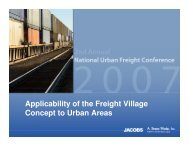Table of Tables - METRANS Transportation Center
Table of Tables - METRANS Transportation Center
Table of Tables - METRANS Transportation Center
You also want an ePaper? Increase the reach of your titles
YUMPU automatically turns print PDFs into web optimized ePapers that Google loves.
Evaluating the Feasibility <strong>of</strong> Electrified Rail at the<br />
Port <strong>of</strong> LA/LB<br />
1 Introduction<br />
Goods movement through the Ports <strong>of</strong> San Pedro has bogged down in recent years due to<br />
truck c ongestion c aused b y t he r apid i ncrease i n c ontainer t raffic and t he l ocal<br />
communities’ understandable reluctance to accept added pollution that accompanies port<br />
growth. The immediate solution for truck congestion is near-dock rail. T he solution to<br />
the air and noise pollution caused by increased rail movement is rail electrification. The<br />
objective <strong>of</strong> this project was to analyze the cost and feasibility <strong>of</strong> available, standardized<br />
equipment for rail e lectrification retr<strong>of</strong>it in t he LA ba sin, a nd to better de fine i ssues<br />
involved in electrified “shuttle-trains” for both commercial a nd military goods<br />
movement.<br />
This project w as t o determine t he utility <strong>of</strong> bl ock switched, third rail e lectrification <strong>of</strong><br />
existing and planned near-dock rail at the Port <strong>of</strong> LA/LB using comparisons with existing<br />
and proposed rail electrification projects in other locals. Determination <strong>of</strong> feasibility was<br />
based on consideration <strong>of</strong> t hree general i ssues i nvolved i n t he t ransition f rom<br />
conventional t o e lectrified r ail: ( 1) or der <strong>of</strong> m agnitude c apital and op erational c ost<br />
projections, ( 2) pr ojected ope rational ut ility f or ne ar-dock a nd s hort ha ul, a nd ( 3)<br />
projected ope rational s afety. Initially, t he p roposed s tudy, s idestepped ove rhead<br />
caternary electrification in favor <strong>of</strong> on-ground third rail due to the apparent awkwardness<br />
<strong>of</strong> overhead lines at port complexes; however, recent developments in Europe where the<br />
caternary can be powered down and swung clear <strong>of</strong> the track have mitigated this concern.<br />
However, e ven w ith t he a dded consideration <strong>of</strong> overhead c aternary, w e conclude, t hat<br />
neither electrification approach is practical for near-dock rail retr<strong>of</strong>it; but due to economy<br />
and safety, overhead electrification is the more practical <strong>of</strong> the two approaches to retr<strong>of</strong>it<br />
freight rail away from and beyond the port complex.<br />
The approach to this pr oject f or de termining the c ost a nd utility <strong>of</strong> electrification for<br />
existing a nd pl anned ne ar-dock r ail a t t he P ort <strong>of</strong> LA/LB c onsisted <strong>of</strong> t hree tasks: (1)<br />
determining the length <strong>of</strong> rail to be considered for electrification; (2) the material cost <strong>of</strong><br />
electrification including rail r etr<strong>of</strong>it, locomotive modi fication, and power di stribution;<br />
and (3) the operational considerations <strong>of</strong> retr<strong>of</strong>it electrification.<br />
Task 1: The length <strong>of</strong> r ail s ubject to possible electrification for Diesel pollution<br />
mitigation was quantified. Near-dock rail was assumed to consist <strong>of</strong> rail sidings at major<br />
terminals in both ports as well as rail on property managed by the Ports and used by the<br />
class-one r ails t o a ccess t he t erminals. T o r espond t o Diesel pollution pr oduced b y<br />
moving cargo out <strong>of</strong> ports, the rail lines to the UP ICTF and the proposed BNSF SCIG<br />
were included as candidates for electrification. Since the BNSF SCIG is only proposed,<br />
the length <strong>of</strong> a single line <strong>of</strong> the Alameda Corridor to the downtown Hobart yards was<br />
also included.<br />
1




